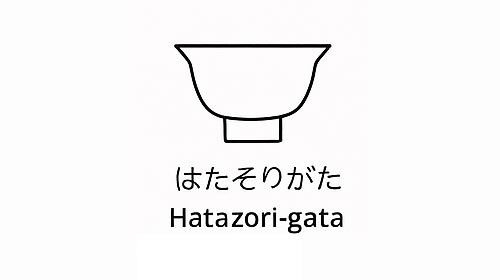If there's one matcha bowl that resonates like a quiet keynote throughout Japanese tea culture, it's the Wan-nari Chawan . It's so natural that it's barely noticeable—and yet it's the origin of countless variations. "Wan" (椀) simply means "bowl" or "cup"; "nari" (形) refers to the shape. So, this isn't an exotic, specialized form, but the original vessel that holds tea—and makes it accessible in the first place.
Form as a functional ideal
The Wan-nari chawan is neither deliberately deep nor noticeably shallow, neither strictly cylindrical nor excessively curved. Its proportions are balanced , usually in a 1:1.2 ratio between height and diameter. The walls rise gently, and the rim is slightly open, but not overly protruding.
It's precisely this balance that makes it the preferred vessel for usucha , the preparation of thin matcha. The chasen can move freely without any limitations—neither too wide, which would cause the foam to lose its shape, nor too narrow, which would make whisking difficult.
The interior is harmoniously round, and the base is often slightly curved, allowing the bamboo whisk to be guided centered during beating. The outer wall is comfortable to hold, and the thickness ensures a pleasant feel without a heavy feel.
The foot as a sign of grounding
The kōdai (base) of the Wan-nari chawan is medium-high, clearly cut, and usually unglazed. It is not dominant, yet provides the bowl with a stable base—a point of balance that is not only functionally but also aesthetically important.
This point is particularly crucial in the tea ceremony, where every movement has meaning: lifting, turning, and replacing the bowl does not happen by chance – and the kōdai forms the material backbone for this.
Production and ceramic traditions
The Wan-nari Chawan is not the invention of a particular kiln or era. Rather, it is a basic form that appears in almost all major ceramic regions of Japan:
-
In Seto it is often decorated with transparent glazes or with Kuro-Oribe elements
-
In Shigaraki it appears with a touch of natural ash, coarse shards and an archaic appearance
-
In Mino they are often seen with Shino or Ki-Seto glazes, sometimes with iron inlays or Hakeme brush marks
-
Wan-nari is also present in Raku-yaki , the low-temperature firing method – especially in black or red Raku
This diversity of origin reflects its function: universal, open, accessible .
Historical significance
The wan-nari shape is probably the oldest standardized tea bowl shape in Japan. Bowls of this type can be found in monasteries and courtly tea culture as early as the early Muromachi period (14th–16th centuries). Unlike specialized chawan bowls such as the ido bowl (suginari) or the hira-gata, the wan-nari has always been an everyday object—and therein lies its value.
In the formal language of Wabi-cha , as coined by the tea-path master Sen no Rikyū , the Wan-nari represents that which is neither intrusive nor hidden—but simply there . A bowl that holds tea because it wants to be drunk.
Aesthetics in use
The Wan-nari is a bowl for every occasion , and therein lies its profound value. It is used in traditional tea ceremonies as well as in modern contexts, in tea salons, cafes, or at home.
Their neutral shape allows for a variety of glazes – from classic white (Kohiki) to pale green tones (Oribe) to heavily grained natural clay surfaces with ash nuances.
The tea master can influence the mood of the ceremony by choosing the bowl – a shiny glazed Wan-nari appears festive and present, a matte, earthy version conveys restraint and depth.




Leave a comment
This site is protected by hCaptcha and the hCaptcha Privacy Policy and Terms of Service apply.